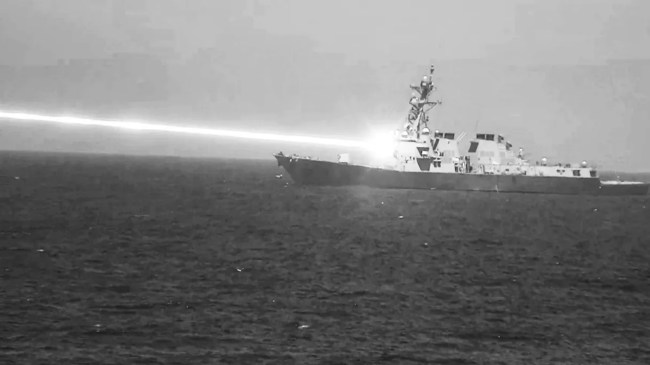US Navy
The U.S. Navy has revealed that it tested out its High Energy Laser and Integrated Optical Dazzler and Surveillance (HELIOS) by shooting an aerial target drone out of the sky. It took place on the Arleigh Burke class destroyer U.S.S. Preble at some point during the Navy’s Fiscal Year 2024.
According to the Pentagon’s 2024 Director, Operational Test and Evaluation (DOTE) report, “CCM [Center for Countermeasures] supported the Navy’s demonstration on U.S.S. Preble (DDG 88) to verify and validate the functionality, performance, and capability of the HEL with Integrated Optical Dazzler and Surveillance system against an unmanned aerial vehicle target. CCM collected imagery of the engagements to support the evaluation of system performance.”
The War Zone reports that Navy higher-ups have been clamoring for the capability the HELIOS can provide. One of the big reasons for that it that “Navy warships shoot down an at-times daily barrage of drones and missiles fired by Iran-backed Houthi rebels over the Red Sea and Gulf of Aden.”
It can also serve as a “dazzler” to blind or confuse optical seekers on incoming missiles and drones. The dazzler can limit an opponent’s general situational awareness by denying their sensors the ability to surveil the ship. HELIOS also sports its own optical sensors, which can serve a secondary intelligence, surveillance, and reconnaissance (ISR) role.
On Preble, HELIOS sits on the warship’s main forward pedestal that hosted the Mk 15 Phalanx Close-In Weapons System (CIWS) on earlier Arleigh Burke class destroyer variants. Flight IIA destroyers currently have only one CIWS installed above the hangar bay. Outside of the handful of destroyers modified to the ‘Rota configuration,’ which feature SeaRAM and Phalanx, Flight I Arleigh Burkes feature two CIWS, front and rear.
The US Navy released a clip of the USS Preble firing a HELIOS laser weapon.
The High Energy Laser with Integrated Optical-Dazzler and Surveillance will be used primarily to counter UAV.pic.twitter.com/5ZhzNMKukE
— Massimo (@Rainmaker1973) February 3, 2025
In May 2020, the U.S.S. Portland used a Solid State Laser – Technology Maturation Laser Weapon System Demonstrator (LWSD) MK 2 MOD 0 to disable an unmanned aerial vehicle. The Navy calls systems like the LWSD and HELIOS as directed-energy weapons (DEWs), which are defined as “electromagnetic systems capable of converting chemical or electrical energy to radiated energy and focusing it on a target, resulting in physical damage that degrades, neutralizes, defeats, or destroys an adversarial capability.”
Naval News further explains, “The U.S. Navy’s laser weapons programs fall into two broad families. One is the Navy Laser Family of Systems (NLFoS). The U.S. Navy’s Surface Warfare Division (N96) manages development of Surface Navy Laser Weapon System Increment One (HELIOS) and the Optical Dazzling Interdictor, Navy (ODIN). The other is the U.S. Navy’s Innovation, Technology Missions, and Test and Evaluation Division (N94) family, which included development of the Solid State Laser – Technology Maturation (SSL-TM) and Ruggedized High Energy Laser (RHEL).”
Unfortunately, despite how cool it looks, HELIOS and other directed-energy weapons are still far from being practical. As The War Zone explains, they can only engage one target at a time, they have power and thermal limitations, their range is limited and impacted by atmospheric conditions, and their components are still too delicate for practical military use.

